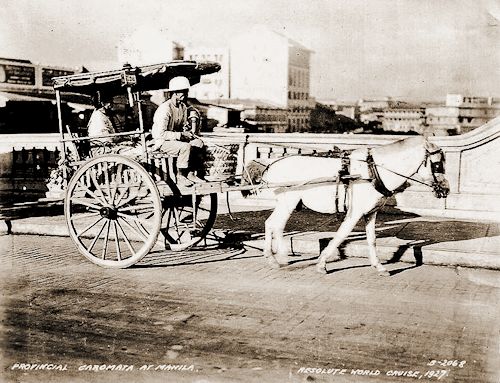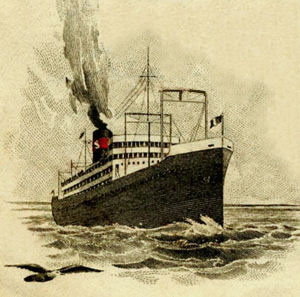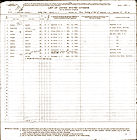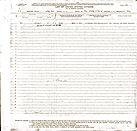Chapter 10
SEASICK

Monday morning (January 28, 1924) came after an almost sleepless night. Such was my excitement and anticipation. I called Mr. Hall and told him that I was back from Taal and asked him for instructions. He told me that he had my steamship tickets and other papers and for me to be at the pier where the S. S. President Lincoln was docked at four o'clock. She was to sail at five.
I had all the things Mr. Hall had bought for me packed along with my precious report cards and Intermediate Graduation Certificate. Cousin Melicia and her husband continued to try to dissuade me from leaving with Mr. Hall. It was understandable. She would lose a valuable household and business helper.
Three o'clock came and I told Melicia and her husband that it was time to go. They then decided that they would take me to the pier and started to dress. This took several minutes. Then, we had to look for a caromata. It seemed that none would appear.

A caromata in Manila, 1927.
We waited many precious minutes before one finally came. I knew it was nearing four, so I told the driver I would give him an extra peso if he would drive his horse faster. I had to be on the pier by five. Sure enough, we reached the pier before five. But the caromata was not allowed to drive to the foot of the ship's gangway; and we had to walk some distance to it.
As we were getting out of the caromata, the ship's whistle sounded and I saw a string of people getting off the ship. Almost breathless, I reached the foot of the gangway with Cousin Melicia and her husband right behind me. After saying our last good bye, I started up the gangway to the ship.
I was stopped by the ship's officer at the foot of the gangway. He wanted to see my passage ticket. I told him that a Mr. William G. Hall had it and explained my situation the best I could. He called one of the crew and gave him some instructions. The man climbed up the gangway and disappeared into the ship.
The exit of the visitors from the ship ended and the order was given for the gangway to be pulled up. The ship's officer told me he was sorry but he could not let me go aboard without a ticket. The sailor he had sent up minutes ago had not reappeared. All this time, people on the docks were shouting good byes to their friends and relatives on the ship who were throwing serpentine streamers to the dock below.
I was scanning the faces on the rail of the ship for my benefactor, when the gangway started up. The heavens seemed to be falling in on me. I can not explain how I kept my equilibrium without falling in a faint during those tense moments when the gangway, my bridge to a bright future, was moving up. I was rendered too numb by what was happening to even cry.
Just when the darkness of the falling heavens was about to overwhelm me, Mr. Hall appeared at the rail beside the seaman who had been sent aboard by the ship's officer. I felt like a person being resurrected from the dead. Mr. Hall made a sign of recognition from the ship's bridge and shouted to me, but I could not hear him. The sailor disappeared from his side after I was pointed out to him.
In a few seconds, the upward motion of the gangway stopped and it was lowered again. I was motioned to come aboard by the same officer who had stopped me from boarding minutes ago. So, in such a dramatic way, I left my native land and all my loved ones.
Entering the confines of the ship was like entering a new world. After depositing my suitcase in cabin 99, I went to the ship's rail and waved good bye to Melicia and her husband, who disappeared from view in less time than I could write about it.
The S.S. President Lincoln sailed from Manila, Jan. 28, 1924, stopping at Hong Kong on Feb. 1, Shanghai on Feb 4, Kobe, Japan on Feb. 8, Yokohama, Japan on Feb. 9, landing in Honolulu on Feb. 17, 1924. Click manifests to enlarge.

The S.S. President Lincoln.
|

Ship manifest for Felipe.
|

Ship manifest for Mr. Hall.
|
Mr. Hall just smiled when I told him what had happened and why I was late. He said he understood. And, that was that. Then he told me how I had been the object of a search on and off the ship, when I did not appear by 4:30.
The captain, who was Mr. Hall's friend, had ordered a search in the steerage section of the ship, where there were many Filipinos who were being carried to Hawaii as contract sugar plantation workers. It was thought that I might have mingled with them, thinking that I belonged there instead of in the first class cabin with Mr. Hall.
Cabin 99 on the S.S. President Lincoln was directly below the captain's quarters and near the main dining room. The double bed was occupied by Mr. Hall and I occupied the bottom of a Pullman type bunk. The two port holes on the forward side of the cabin admitted the fresh and cool ocean breeze which I learned to love so much.
As soon as the ship left Manila Bay, the sea began to get rough and the ship started to roll. By the time the supper gong sounded, I was already seasick.
This malady stayed with me throughout my entire maritime career of over forty years. Even now, I get seasick when I go out fishing in small boats in the bay.
I laid in my bunk and listened to the orchestra playing dinner music until it lulled me to sleep. The next day was the same: I was seasick. I remember being able to eat only a couple of apples until we docked in Hong Kong.
Most of the trip, when the sea was rough, I had my meals served in my cabin. Occasionally, I would go to the steerage section of the ship and have my meal there, because the food prepared in Oriental style by Chinese cooks was more to my taste.
In the ports of Hong Kong, Shanghai, and Yokohama, Mr. Hall took me ashore on his shopping trips. In Shanghai, we visited an American couple living at the Cathay Hotel. They must have been old friends. When he told them who I was and our relation, the lady told me how lucky I was.
My most vivid recollection of the ports we visited was the sight of the sampan people in Hong Kong and Shanghai, who lived by scavenging the garbage thrown from the ships in the harbor. I noted that there were no sea gulls in those two ports.
In Hong Kong, the ship picked up some Indian steerage passengers bound for Hawaii and San Francisco. After we left Yokohama, the sea became calm and I enjoyed my trip better. With Mr. Hall and the Captain's permission, I went to the steerage section of the ship to talk to the Filipino passengers. I even played cards with them a few times.
Halfway to Honolulu, one of the Indian passengers we had picked up in Hong Kong was taken ill and diagnosed as having small pox. All the steerage passengers were vaccinated. I, too, had to be vaccinated because I had mingled with the steerage passengers.
The ship arrived in Honolulu quarantine station early in the morning on February 17, 1924. The sick passenger was taken ashore immediately; and the quarantine doctor examined all the passengers who had been vaccinated. Behold! I was one of the several whose vaccinations did not take, so I was ordered to be quarantined.
Continue to next chapter...

(Introduction)
(Contents)
(Chap 1)
(Chap 2)
(Chap 3)
(Chap 4)
(Chap 5)
(Chap 6)
(Chap 7)
(Chap 8)
(Chap 9)
(Chap 10)
(Chap 11)
(Chap 12)
(Chap 13)
(Chap 14)
(Chap 15)
(Chap 16)
(Chap 17)
(Chap 18)
(Chap 19)
(Chap 20)
(Chap 21)
(Chap 22)
(Chap 23)
(Chap 24)
(Chap 25)
(Chap 26)
(Chap 27)
(Chap 28)

|